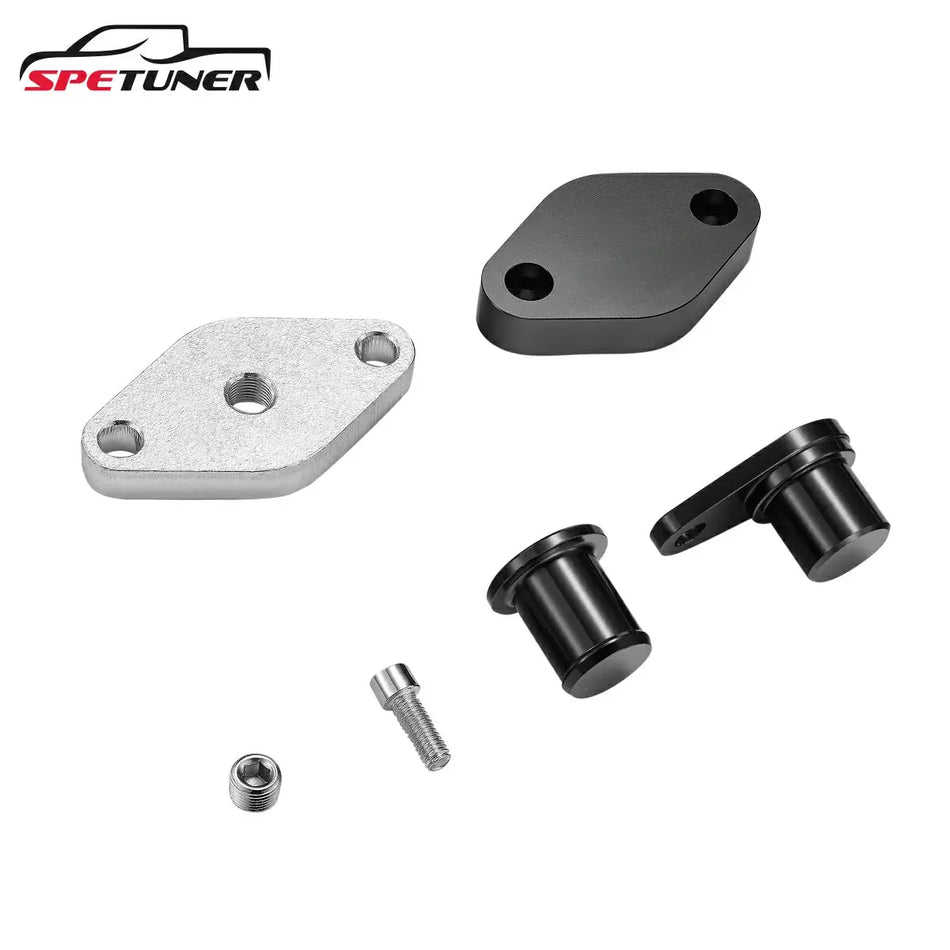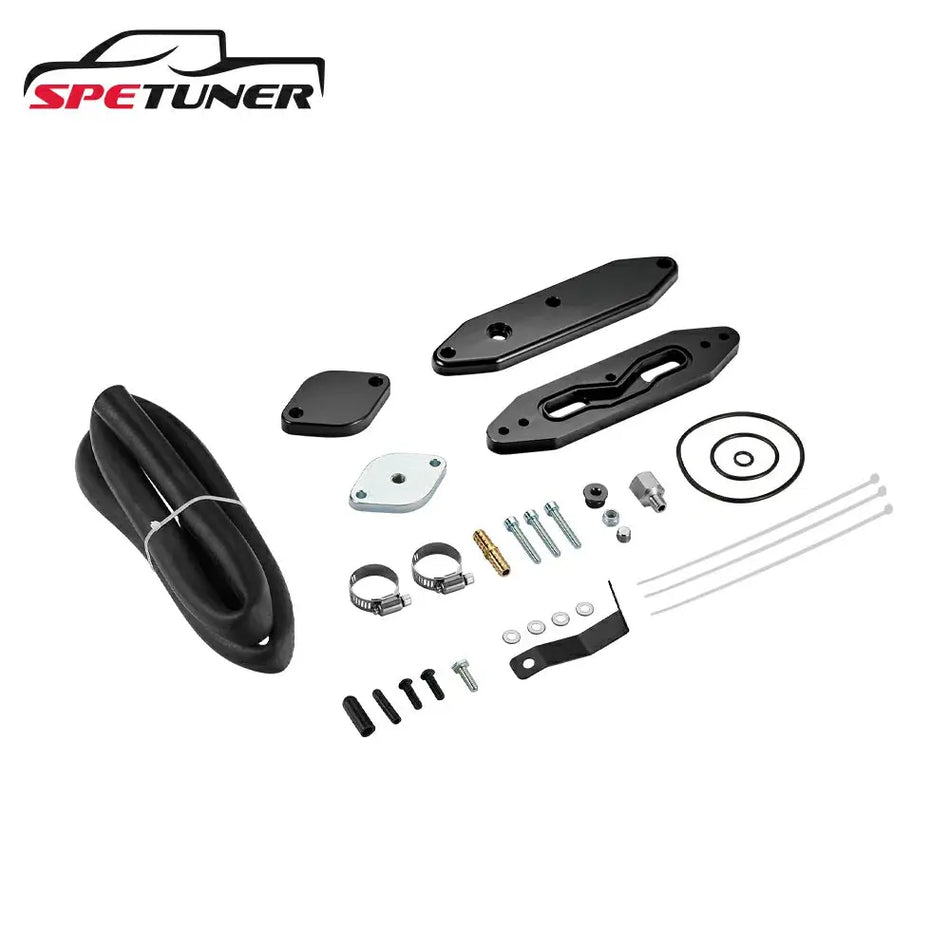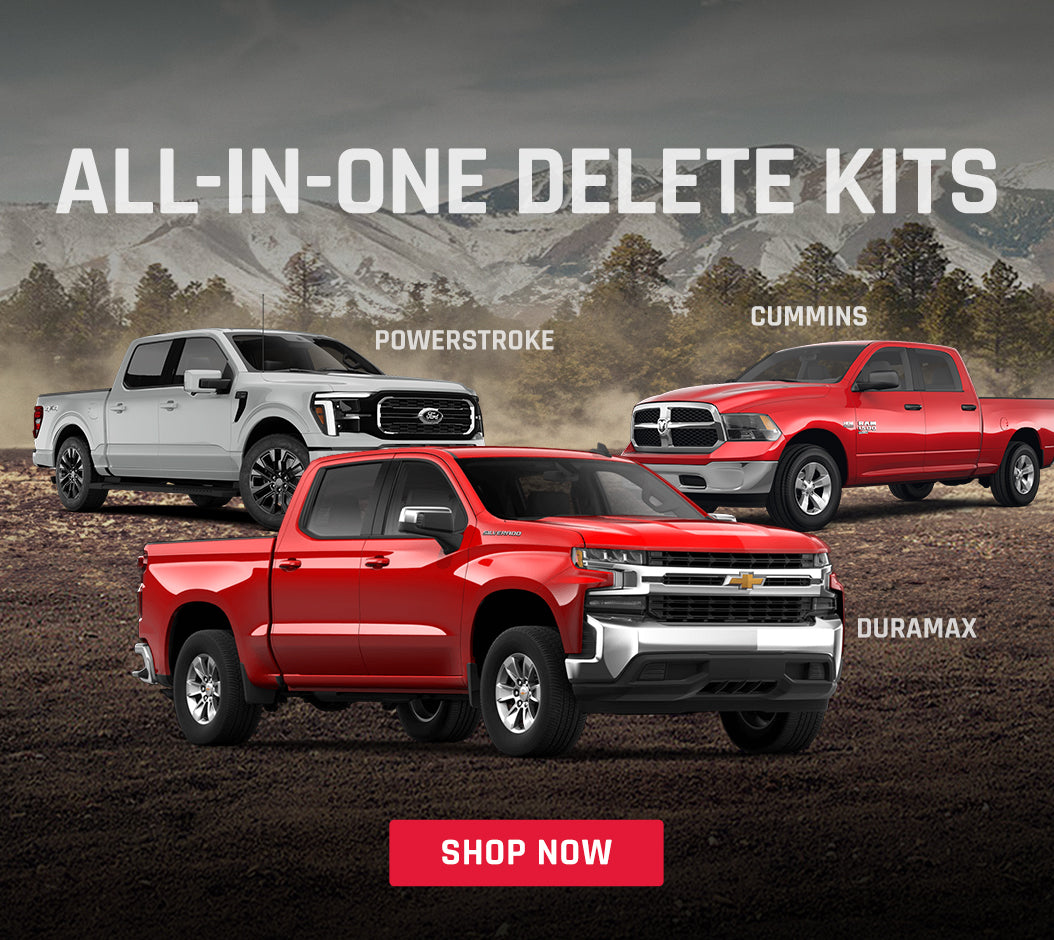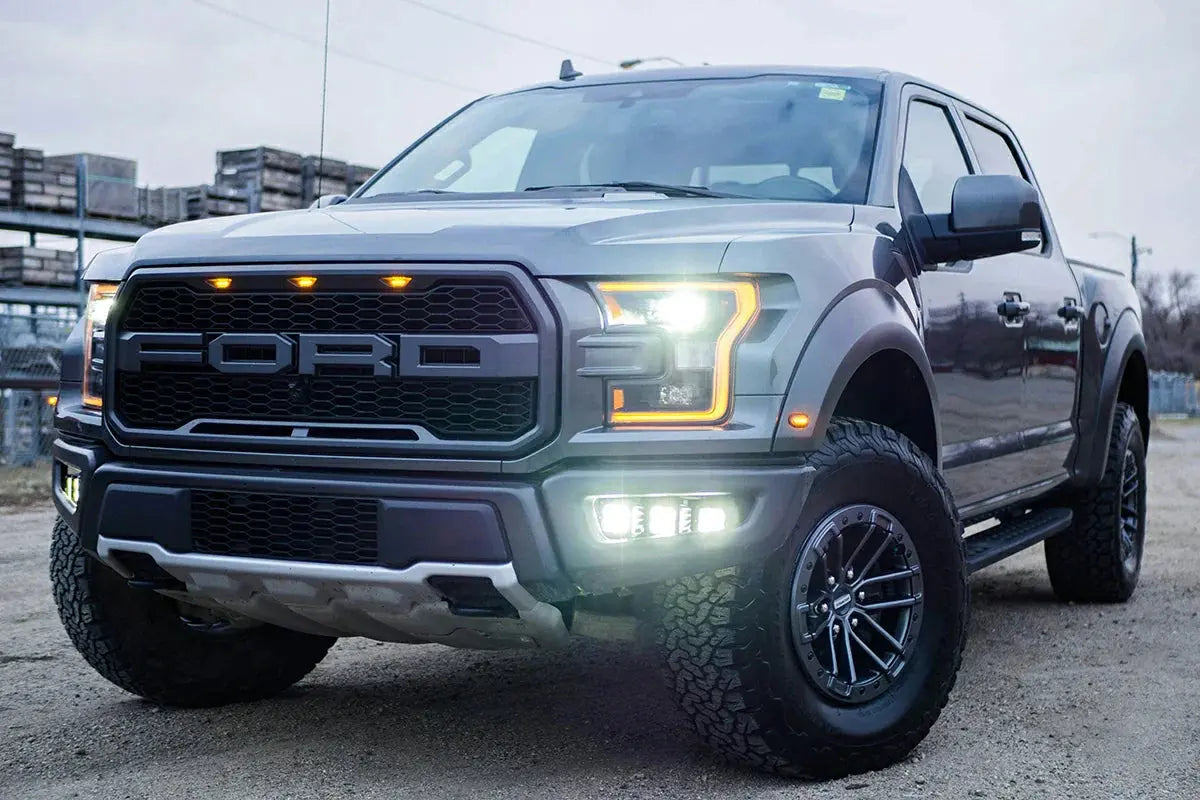This guide explains what an EGR delete kit is, how it works, what the potential benefits and downsides are, and which platforms it fits. Whether you drive a Powerstroke, Duramax, or Cummins, the goal here is to help you make an informed decision for off-road use only.
Understanding the EGR System
EGR stands for Exhaust Gas Recirculation—an emissions control technology designed to reduce nitrogen oxide (NOx) emissions. In simple terms, it routes a portion of exhaust gases back into the intake so they can be burned again.

Why Manufacturers Use EGR Systems
By recirculating a controlled amount of exhaust gas back into the combustion chamber, the EGR system lowers peak combustion temperatures, which helps reduce NOx—one of the main contributors to smog and air pollution.
Because of strict federal emissions standards, modern diesel trucks must meet specific NOx limits. From the manufacturer’s perspective, the EGR system is part of how they balance performance, fuel economy, and regulatory compliance.
How the Factory EGR System Works
A typical EGR system includes:
- EGR Valve: Electronically controlled valve that meters how much exhaust is recirculated.
- EGR Cooler: Uses engine coolant to reduce exhaust gas temperatures before re-entry.
- EGR Tubes/Pipes: Carry exhaust from the exhaust manifold to the intake side.
- Sensors and Solenoids: Monitor flow and temperatures and report back to the ECU.
During operation, the ECU opens the EGR valve under specific conditions, allowing exhaust gases to flow through the cooler and back into the intake manifold, where they mix with fresh air and fuel.
Common EGR Problems That Push Owners Toward Changes
So why do we want to delete the EGR system? While the EGR system helps trucks pass emissions tests, it can cause several long-term issues:

- Carbon and Soot Buildup: Recirculated exhaust carries soot that coats the intake manifold, valves, and ports. Over time, this buildup restricts airflow and reduces efficiency.
- EGR Cooler Failures: EGR coolers see constant heat cycling and can crack or leak. Coolant entering the exhaust stream can cause white smoke, coolant loss, and in severe cases engine damage.
- Reduced Engine Performance: Because exhaust displaces oxygen-rich intake air, the EGR system can soften throttle response and reduce power.
- Increased Maintenance Costs: EGR valve replacements, cooler failures, and intake cleanings can easily add up to thousands of dollars over the life of the truck.
If you want a broader picture of how emissions systems affect modern diesels, you can also read our complete overview of modern diesel emissions changes.
What Is an EGR Delete Kit?
An EGR delete kit is an aftermarket performance package designed to remove or bypass the exhaust gas recirculation system on a diesel engine. It replaces the EGR hardware with plates, coolant rerouting parts, and related components so that exhaust is no longer recirculated into the intake.
Other Names You Might See
You may see different terms used in the diesel community, such as:
- EGR bypass package
- EGR removal setup
- EGR valve removal kit
- EGR block-off package
Different brands may use slightly different labels, but the core idea is the same: removing the EGR system’s impact on the engine for off-road or competition use.
What It Changes on a Diesel Engine
Practically speaking, this type of upgrade stops exhaust gas from being routed back into the intake. Instead of hot, soot-filled exhaust mixing with intake air, the engine breathes only fresh, oxygen-rich air.
Before and After: System vs. No System
With the stock system:
- Exhaust gases are routinely recirculated through the engine.
- Intake components gradually clog with soot and carbon.
- Combustion temperatures are lowered by design.
- Regular EGR-related maintenance and repairs are common.
With the system removed (off-road only):
- Only fresh intake air flows into the engine.
- Intake components stay far cleaner over time.
- Combustion conditions can be optimized for power and efficiency.
- EGR-specific failure points are eliminated.
Off-Road and Competition Use Only
It’s critical to stress that these modifications are intended only for off-road, racing, and competition use. They are not legal for on-road use in the United States or in regions where intact factory emissions equipment is required.
SPETUNER solutions are engineered for closed-course competition, off-road applications, or markets with different regulations. Always check and follow local laws before modifying any emissions system.
What’s Included in an EGR Delete Kit?
Core Components
A well-designed package typically includes:

- Block-Off Plates: Precision-machined plates that seal the openings where the EGR valve and cooler used to connect. SPETUNER uses 304/409 stainless steel or high-grade aluminum for strength and heat resistance.
- Coolant Bypass Tubes/Pipes: Since the EGR cooler is part of the cooling circuit, removal requires rerouting coolant. Bypass tubes maintain proper flow without the original cooler.
- Gaskets and O-Rings: High-temperature gaskets provide leak-free sealing. Quality packages include OEM-spec or better components rated for diesel use.
- Mounting Hardware: Grade 8 bolts, stainless clamps, and other fasteners needed for a secure installation.
- Up-Pipes (Where Required): Some platforms, especially certain Powerstroke engines, need replacement up-pipes that remove the original EGR feed port entirely.
Why Material Quality Matters
- 304 Stainless Steel: Excellent corrosion resistance and high-temperature strength.
- 409 Stainless Steel: More affordable, still very suitable for exhaust temperatures.
- Billet Aluminum: Lightweight and precise, ideal for some block-off plates and fittings.
- Mild Steel: Common in budget options, but more likely to rust or warp over time.
Platform-Specific Variations
Each engine family needs its own layout and parts:
6.7L Powerstroke
- Vertical EGR cooler design with year-specific changes.
- Longer coolant bypass routing.
- Potential intake elbow and sensor differences by model year.
6.7L Cummins
- Horizontal EGR cooler plates.
- Throttle valve-related provisions on some packages.
- Grid heater compatibility to consider.
Duramax Platforms (LLY, LBZ, LMM, LML, L5P)
- Different coolant routing between generations.
- Unique mounting points and sensor layouts for each engine code.
- Some LML and L5P applications require additional sensor solutions.
3.0L EcoDiesel (Ram / Jeep)
- Compact components for tight engine bays.
- Distinct coolant flow and sensor configurations.
- Requires parts designed specifically for this engine.
For a deeper look at how these upgrades compare to other emissions changes, you can review our detailed breakdown of power and fuel-efficiency gains.
How an EGR Delete Kit Works on Your Engine
Installing this kind of package changes how your engine breathes and cools itself in three main ways:
- Blocking Exhaust Recirculation: Block-off plates seal the ports that once fed exhaust into the EGR system, stopping recirculated exhaust from reaching the intake.
- Rerouting Coolant: Bypass tubes take over the coolant path that previously flowed through the EGR cooler, maintaining cooling system function.
- Updating ECU Strategy: With proper tuning, the ECU no longer tries to operate the original EGR system, preventing fault codes and limp mode.
What Changes in Everyday Use (Off-Road)
- Cleaner Intake Air: Without exhaust dilution, your engine receives 100% fresh intake air, maximizing oxygen for combustion.
- Improved Exhaust Flow: Removing EGR-related restrictions can reduce backpressure and improve turbocharger response.
- Smoother Operation: Many owners report more linear throttle response and smoother acceleration when the setup is properly tuned.
Interaction with Other Systems
- Turbocharger: May spool quicker with less backpressure.
- Intake Manifold: Stays much cleaner over time.
- Fuel System: Tuning can optimize fueling for the new airflow profile.
- Cooling System: No longer needs to shed heat from the EGR cooler, which can help stabilize temperatures.
Benefits of EGR Delete Kits (Off-Road Use Only)
Power and Performance
Real-world results vary, but many owners report:
- 20–30 HP gains on otherwise stock trucks with proper calibration.
- 30–50 HP or more when combined with additional performance upgrades.
- Improved torque across the usable RPM range.
- Sharper throttle response and smoother acceleration.
Fuel Efficiency
For trucks used off-road, many drivers see:
- Noticeable improvements in fuel consumption under certain conditions.
- Better efficiency when towing or hauling heavy loads.
- More stable MPG over time as carbon buildup is reduced.
Reliability and Maintenance
When installed and calibrated correctly, removing the EGR system for off-road use can:
- Lower Maintenance Costs: EGR valve replacements, cooler failures, and intake cleanings are greatly reduced or eliminated—services that often cost $800–$2,500 per visit.
- Reduce Failure Points: The EGR cooler and related hardware, which are common sources of breakdowns, are taken out of the equation.
- Keep Oil and Components Cleaner: Less soot entering the intake can mean cleaner oil and reduced wear.
If you’d like to dig even deeper into this topic, check out our in-depth overview of the advantages and disadvantages of EGR system changes.
Installation Overview (High-Level)
DIY vs. Professional Installation
Difficulty varies by platform, but installs are generally in the moderate range.
DIY-friendly if you have:
- Solid mechanical experience.
- A complete tool set and torque wrench.
- Access to a service manual or repair database.
- 4–6 hours of focused work time.
Professional installation is recommended if:
- You’re not comfortable working with cooling systems.
- Your time is limited.
- You want labor warranty and peace of mind.
- You’re adding multiple upgrades at once.
Typical Time Requirements
- Experienced mechanic: 2–3 hours.
- Skilled DIYer: 3–5 hours.
- First-time installer: 4–6 hours.
High-Level Installation Steps (For Reference Only)
-
Preparation
- Let the engine cool completely and disconnect the batteries.
- Safely drain coolant into a suitable container.
-
Remove Factory Components
- Remove covers and intake parts as needed for access.
- Disconnect electrical connectors and coolant lines from the EGR hardware.
- Remove the EGR valve, cooler, and related pipes.
-
Install Block-Off Plates and Bypass Tubes
- Clean gasket surfaces carefully.
- Install plates and coolant bypass hardware with supplied gaskets.
- Torque fasteners to the kit’s specifications.
-
Reassemble and Test
- Refill and bleed the cooling system.
- Start the engine and check for leaks.
- Monitor temperatures and behavior on the first few drives.
For platform-specific step-by-step examples, you can reference guides such as our installation overview for late-model Cummins trucks.
EGR Delete Kit Compatibility by Platform
Ford Powerstroke Applications
SPETUNER offers platform-specific Ford EGR delete solutions for popular Powerstroke engines:
6.0L Powerstroke (2003–2007)
- Known for high EGR cooler failure rates.
- Often paired with head stud upgrades in performance builds.
6.4L Powerstroke (2008–2010)
- Dual EGR cooler setup with more complexity.
- Can see notable reliability and drivability improvements in off-road configurations.
6.7L Powerstroke (2011–2023)
- Vertical EGR cooler layout with year-specific changes.
- Requires carefully matched hardware and calibration.
Ram Cummins Applications
We offer EGR delete kits for RAM Cummins from 2007-2025:
5.9L Cummins (2004.5–2007)
- Relatively simple system compared to later models.
- Popular on high-mileage work trucks used off-road.
6.7L Cummins (2007–2023)
- Multiple emissions system revisions across the years.
- Strong candidates for complete off-road packages when legally used.
GM Duramax Engines
SPETUNER’s EGR Delete Kits for Duramax 2004-2025. Improve power, fuel efficiency, and engine life with kits designed for LBZ, LLY, LML, LMM, and L5P models.
- LLY (2004–2005): Often targeted for overheating and EGR issues.
- LBZ (2006–2007): Already robust, but can benefit in heavy-use scenarios.
- LMM (2007.5–2010): Early DPF-era trucks with more complex emissions systems.
- LML (2011–2016) & L5P (2017–2023): Highly integrated emissions controls requiring engine-specific solutions.
If you run an L5P and want to explore your options in more detail, you can review our L5P Duramax upgrade guide for off-road configurations.
3.0L EcoDiesel (Ram / Jeep)
Smaller-displacement diesels like the 3.0L EcoDiesel also have platform-specific requirements, including compact components, tight clearances, and unique coolant routing. Only use parts that are engineered for your exact year and model.
Tuning Requirements After EGR Removal
Why Calibration Is Essential
In practice, proper calibration is required. Without it, the ECU still tries to run the original EGR strategy, which can cause:
- Check engine lights and stored trouble codes.
- Reduced power or limp mode.
- Incomplete performance and drivability gains.
Common Tuning Platforms
EZ Lynk
- Cloud-based tune delivery and updates.
- Real-time data logging and monitoring.
EFI Live
- Professional-grade software with deep ECU access.
- Popular for high-power custom builds.
SCT and Similar Devices
- User-friendly handheld tuners.
- Preloaded calibrations for common platforms.
For a focused discussion on this part of the process, see our article on why ECU calibration after emissions changes matters.
Legal Considerations and Disclaimers
Is This Legal on the Street?
For on-road use in the U.S., no. Any modification that removes or disables factory emissions equipment, including EGR systems, violates the federal Clean Air Act in all 50 states. Significant fines are possible for both installers and vehicle owners.
Where It Can Be Used
These changes are intended only for:
- Closed-course racing and track use.
- Off-road-only vehicles.
- Certain agricultural, industrial, marine, or export applications where regulations differ.
Enforcement and Testing
- Federal: The EPA enforces Clean Air Act violations.
- State: Many states perform visual inspections and OBD checks.
- Emissions testing: Modified vehicles typically fail emissions inspections.
Warranty and Resale Impact
Making these changes can:
- Void parts of the factory powertrain warranty.
- Affect extended warranty coverage.
- Complicate resale in markets with strict emissions enforcement.
For an updated look at the rules, you can read our overview of the current legal status of these modifications and our article on the latest diesel emissions regulations in 2025.
EGR Delete Pros and Cons
Advantages
- Potential 20–50 HP gains with proper calibration in off-road setups.
- Improved fuel efficiency reported in many real-world cases.
- Fewer EGR-related failures and repair bills.
- Cleaner intake components and reduced carbon buildup.
- More stable operating temperatures under load.
Disadvantages
- Not legal for on-road use in regions that require intact emissions systems.
- Possible fines and inspection failures.
- Loss of factory warranty coverage on related systems.
- Upfront hardware, tuning, and installation costs.
Read more: Should You Delete EGR or DPF? Pros, Cons, and Expert Advice
Is It Harmful for the Engine Itself?
When done correctly for off-road use with proper calibration, removing the EGR system is generally not harmful to the engine and may support longer-term durability by reducing soot contamination. However, poor-quality parts, rushed installs, or bad tuning can create new problems.
Cost and Return on Investment
Typical Costs
Total cost depends on the platform, parts quality, and whether the work is DIY or done at a shop:
Hardware ranges:
- Basic packages: $200–$500.
- Premium stainless options: $400–$800.
- Complete off-road packages with tuning and exhaust changes: $1,500–$3,000+.
Installation and extras:
- Independent shop labor: $300–$600.
- Specialized diesel shop: $500–$1,000.
- ECU calibration: typically $500–$1,500.
- Coolant and fluids: $50–$100.
Long-Term Savings
For trucks used legally off-road, many owners view the upgrade as an investment due to:
- Avoided EGR cooler replacements ($1,500–$2,500 per event).
- Eliminated EGR valve cleaning and intake carbon removal services.
- Improved uptime and fewer surprise breakdowns.
For a broader look at how these packages fit into a full build, you can read our introduction to complete diesel upgrade packages.
Common Questions and Troubleshooting
Will This Cause Black Smoke?
A properly calibrated setup should not cause excessive black smoke. If you see heavy smoke, it may indicate:
- Overly aggressive or incorrect tuning.
- Injector issues.
- Restricted air filter or intake system.
- Turbocharger problems.
Typical Post-Install Issues
Check Engine Light: Usually resolved with correct ECU calibration and verifying all connectors and sensors are properly handled.
Coolant Leaks: Often due to loose clamps, improperly seated hoses, or damaged O-rings. Re-check connections and torque specs.
Reduced Power or High EGTs: Can result from incomplete installation, boost leaks, or calibration that needs refinement.
Conclusion: Should You Install an EGR Delete Kit?
You now have a clear picture of what an EGR delete kit is, how it works, and what the main pros and cons look like in real use.
For trucks used where it’s legal, this upgrade can offer strong performance gains, better reliability, and lower long-term maintenance costs. At the same time, the legal and warranty implications for on-road use are serious and should never be ignored.
SPETUNER designs platform-specific solutions engineered for durability, fitment, and performance in demanding off-road environments. Our technical team is available to help you choose the right hardware and calibration strategy for your diesel build.
Important: All SPETUNER products described here are designed and sold exclusively for off-road, racing, and competition use. Always comply with local, state, and federal regulations.
Frequently Asked Questions
Q1: What exactly does an EGR delete kit do?
A1: An EGR delete kit permanently removes the exhaust gas recirculation system, preventing exhaust gases from re-entering your engine's intake. This results in cleaner combustion, more power, and improved reliability.
Q2: How much HP gain from EGR delete?
A2: Most diesel engines gain 20-30 HP from the EGR deletion alone, with properly tuned setups seeing 30-50 HP improvements. Results vary by engine platform and supporting modifications.
Q3: Is EGR delete worth it for my diesel?
A3: For off-road and competition use, absolutely. The performance gains, reliability improvements, and maintenance savings typically outweigh the initial investment within 18-24 months.
Q4: Can I install an EGR delete kit myself?
A4: Yes, if you have basic mechanical skills and 4-6 hours available. However, professional installation ensures proper execution and may include a labor warranty.
Q5: What's included in a complete EGR delete kit?
A5: Quality kits include block-off plates, coolant bypass tubes, gaskets, mounting hardware, and detailed instructions. Premium packages may include tuning solutions.
Q6: Do I need a tuner after EGR delete?
A6: Yes, ECU tuning is essential to prevent check engine lights and optimize performance after EGR deletion. Without proper tuning, you won't realize the full benefits.
Q7: How long does EGR delete installation take?
A7: Professional installation typically takes 3-4 hours. DIY installations range from 4-6 hours depending on experience level and vehicle specifics.









